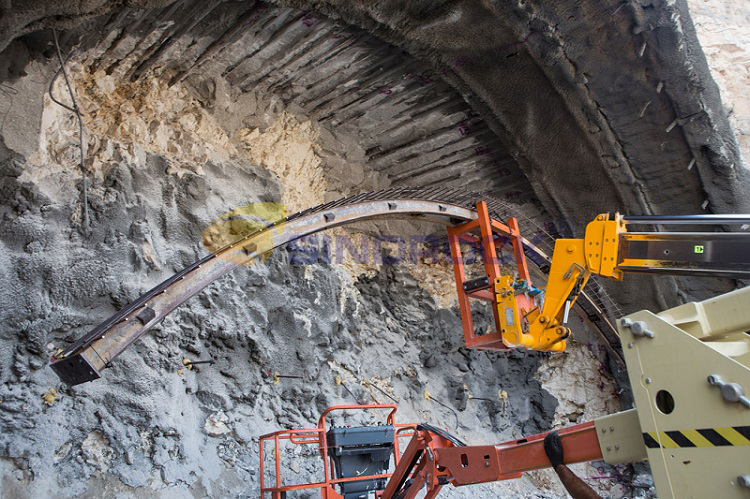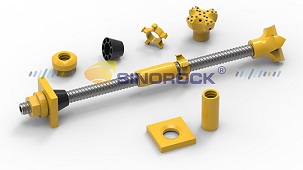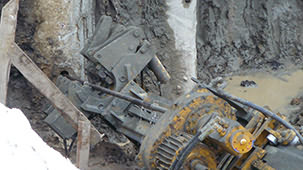You Must Use Self-drilling Anchor Bolts in Easy-to-Collapse Conditions, Click here to Know Why
Time:2022-02-10From:sinorock View:
Many construction companies will encounter geological conditions that are prone to collapsing holes during the construction of engineering projects. In such a situation, it is difficult to carry out construction smoothly and efficiently with traditional casing drilling. Therefore, it is necessary to consider looking for alternative construction schemes. Sinorock suggests here: self-drilling anchor bolts must be used in the geology of easy-to-collapse holes.
So, why must self-drilling anchor bolts be used for easy-to-collapse hole geology?
Since it is difficult to form holes in the geological rock and soil layers that are prone to collapse, if the traditional casing is used for drilling construction, not only the construction process is complicated, but also the construction efficiency is low, and the construction period is likely to be delayed. With the use of self-drilling anchor bolts, these problems can be solved easily.
What is Collapsible Pore Geology?
What is a self-drilling bolt?
How to construct self-drilling anchor bolts?
What is the tensile yield strength of self-drilling anchor bolts?
Why should self-drilling anchor bolts be used for construction of easy-to-collapse hole geology?
What is Collapsible Pore Geology?
In the industry, the geology of easy-to-collapse holes refers to the geology in which the boreholes are easily collapsed due to the geological reasons such as loose rock and soil and broken rocks during drilling construction, making it impossible to insert bolts for subsequent construction operations. This type of geology is characterized by small rock particles that collapse after being shaken or the surrounding interacting part disappears, generally consisting of clay, soft soil, sandy soil, gravel, mixed fill, broken strata, soft sandstone, limestone, pebble layers Wait.
What is a self-drilling anchor bolt?
The self-drilling bolt is composed of six parts: a hollow bolt body, a drill bit, a connecting sleeve, a nut, a backing plate and a centralizer. Its main part is a hollow rod body that acts as a drill pipe and grouting pipe. Before grouting, its hollow feature can be used to blow off the dust formed after rock drilling; the hollow rod body can be used as a grouting channel. It is tightly bonded with the surrounding rock and soil to achieve the purpose of strengthening the rock.


How to construct self-drilling anchor bolts?
1. Preparation before construction: Check whether the functions of the drilling rig are normal, whether the drill bit and the rod body are damaged, and whether the rod body is unblocked, etc. After ensuring that there is no problem, screw the hollow bolt body to be used with the drill bit;
2. Drilling and grouting: The hollow bolt body and the grouting pipe are connected to the drilling rig through a rotary grouting adapter, and grouting is performed during the drilling process to achieve the simultaneous completion of drilling and grouting;
3. The length of the bolt body: if the length of a single self-drilling bolt cannot reach the designed drilling depth, the length of the connecting sleeve can be used to meet the design requirements;
4. Install the backing plate and nut: After the grouting is completed, install the backing plate and the nut in sequence on the exposed part of the self-drilling bolt outside the rock body close to the construction surface to ensure the anchoring effect.
Note: The size of the drill bit can control the size of the drill hole. Generally, the size of the drill hole is about 2-3 times the diameter of the bolt.
At present, many domestic construction companies are still worried about the ultimate load and yield load of the self-drilling hollow bolt body, and believe that the tensile yield load of this hollow rod body is lower than that of other traditional anchoring materials such as steel bars. However, this is not the case. There will be strict quality control in the production process of self-drilling anchor bolts, and the tensile yield strength of the hollow bolt body has been scientifically tested (tensile strength testing machine testing).
For the ϕ25 self-drilling bolt with the smallest diameter (link product R25), its ultimate load is 200kN and the yield force is 150KN; while the ϕ76 self-drilling bolt with a diameter of 76 (link product T76), its ultimate load and The maximum yield load reaches 1900kN and 1500KN, which can meet the support needs of various projects.
Why should self-drilling anchor bolts be used for construction of easy-to-collapse hole geology?
As mentioned above, the geology and soil of easy-to-collapse holes are soft, and the holes are easy to collapse after drilling. It is difficult to complete the construction according to the scheduled construction method using traditional casing follow-up or drill pipe drilling. The construction of self-drilling anchor bolts for easy-to-collapse hole geology can achieve the effect of one-time drilling, synchronous completion of drilling, grouting and anchoring, avoiding the repeated hole cleaning process caused by drilling blockage and collapse, and improving the construction efficiency. .
In the geological construction of easy-to-collapse holes, we will encounter this situation: we first need to use the drill pipe to drill into the construction. After drilling to the design depth, the drill pipe needs to be pulled out and then inserted into the anchor rod or steel bar. When inserting the anchor rod or steel bar, it will be found that the drilled hole may be blocked, and the anchor rod or steel bar may not be able to be inserted to the required depth at all; then we need to use the drill rod to unclog the hole many times, resulting in time Waste, reduce efficiency and prolong construction period.


The geology of easy-to-collapse holes must be constructed with self-drilling anchor bolts. In general, it has the following advantages:
Good applicability: In many projects at home and abroad, self-drilling anchor bolts are the first choice for the geology of easy-to-collapse holes. For example, R32 self-drilling anchor bolts are used for the slope support of Santiago Expressway in Chile, and the slope support of Pocono Raceway in the United States is used. The protection uses T40 self-drilling bolt;
Suitable for construction in narrow spaces: the length of a single hollow bolt body can be cut at any position as required, and the common specifications are 2m, 3m, 4m and 6m;
Simple process flow: drilling, grouting and anchoring of self-drilling anchor bolts are completed at one time, which simplifies the process flow and accelerates the construction speed;
Conducive to stabilizing the hole wall: grouting belongs to pressure grouting. The slurry quickly fills the borehole and the cracks in the rock and soil mass and is absorbed and solidified by the hole wall to ensure the stability of the hole wall.
With the continuous development of economic level, there are more and more construction projects of foundation and foundation engineering, slope engineering, tunnel and underground engineering. Most of these projects need to be supported during construction. Self-drilling hollow bolts have their unique advantages. It is more and more favored by engineers, and it is of great significance to realize the anchoring of the geological conditions of easy-to-collapse holes.
latest news
-

- What Are the Applications of SDA Bolts in Hydropower Stations?
- Time:2025-08-21From:This Site
- Learn how self-drilling anchor bolts enhance slope stability, tunnel support, and dam reinforcement in complex geological conditions at hydropower stations. Optimize hydropower projects with efficient, cost-effective, and eco-friendly solutions.
- View details
-

- Slope Stabilization with SDA Bolts: Benefits & Applications
- Time:2025-08-19From:This Site
- Discover how self-drilling anchor bolts (SDA bolts) provide superior slope stabilization for highways, railways, and tunnels. Learn their key benefits, installation process, and real-world applications in loose or collapsible soils.
- View details
-

- How Self-Drilling Rock Bolts Enhance Tunnel Support in Fractured Rock?
- Time:2025-08-15From:This Site
- Discover how self-drilling rock bolts enhance tunnel support in fractured rock. Learn their benefits, installation steps, and real-world applications for safe, efficient tunneling.
- View details
-

- Sinorock 2025 Quality Month | Strengthening Quality Foundations, Empowering Product Excellence
- Time:2025-08-13From:This Site
- Sinorock’s 2025 Quality Month, themed “Strengthening Quality Foundations, Empowering Product Excellence,” successfully concluded, reinforcing our commitment to superior product quality.
- View details
-

- Sinorock Safety Month 2025 | Everyone Speaks Safety, Everyone Can Respond
- Time:2025-07-03From:This Site
- Sinorock Safety Month 2025, centered on the theme "Everyone Speaks Safety, Everyone Can Respond - Spot Workplace Hazards," has wrapped up successfully!
- View details
-

- Quality Control: the Vital Factor of A SDA Bolt Factory
- Time:2025-01-09From:This Site
- Sinorock’s comprehensive quality control system, from supplier management to outgoing inspections, ensuring the highest standards for self-drilling anchor bolts in construction.
- View details
-

- Sinorock Invites You to Explore Proven Self-Drilling Anchor Bolt Solutions at bauma 2025
- Time:2025-03-07From:This Site
- From April 7–13, 2025, explore Sinorock’s Self-drilling anchor bolt solution at Booth C2.513/4 in Hall C2 of the Messe München Exhibition Center (Munich, Germany).
- View details
-
.jpg)
- SINOROCK to Attend EXPOMINA PERÚ 2024 in Lima, Peru
- Time:2024-08-10From:This Site
- Sinorock to Attend EXPOMINA PERÚ 2024 in Lima, Peru
- View details
-
.jpg)
- SINOROCK to Participate in MINING AND METALS CENTRAL ASIA 2024
- Time:2024-08-08From:This Site
- SINOROCK to Participate in MINING AND METALS CENTRAL ASIA 2024
- View details
 Download
Download 


